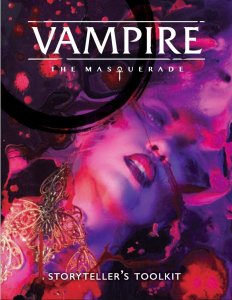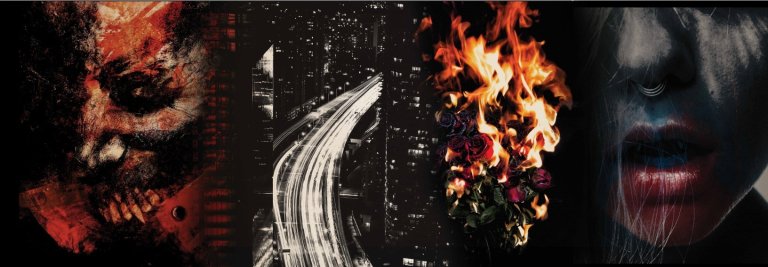There are some game systems where a GM screen can almost feel like a necessity. Until that day in the far future where I finally give up and run everything electronically, a game of Dungeons & Dragons probably involves maps and stat blocks I don’t want the players to see. And I couldn’t possibly play, much less run, a game of Legend of the Five Rings Roleplaying without a cheat sheet for uses of opportunity.

How necessary a storyteller screen is in a World of Darkness game can depend on the storyteller and the game. I really only have old Vampire screens because they came packaged with books I wanted anyway. These days, without the cramped still-in-school budget, I will of course buy the GM screen package for Vampire (or any other RPG I’m excited about).
For the Fifth Edition of Vampire: the Masquerade, that meant picking up the Storyteller’s Toolkit, which has the storyteller screen and softcover booklet. Physically, the screen itself is beyond sturdy (it’s basically the opposite of the old school White Wolf screens, which were typical back then in that they were about as sturdy as a softcover). I say beyond sturdy because it’s really thick – I’ve never had any sturdiness issues with the fairly thick Dungeon Master’s Screen Reincarnated or the Pathfinder GM Screen, and this is way past that. I think my poor, cramped RPG bookshelves are wondering where it is that I think I’m going to find room for it.
I’ve included an image of the fully-expanded screen below (note that this is the final art; the early promo photos do not represent the actual art). It looks reasonably nice. The roses on fire really fits the motif of the Camarilla book, and the bloody face on the right is one of my favorite images from the core book. But it doesn’t really scream “Vampire” in the way I would like it to. I mean, literally, it doesn’t actually say “Vampire: the Masquerade” on it anywhere but in the copyright notice. But with V5 not having the traditional amazing artwork for an iconic set of characters, you can’t feature such art on the storyteller screen.

But, more important than the art is whether the four pages of tables and such are helpful. So I wrote down the things that I find myself (or others) looking up most often during games of V5 vampire:
- What’s the roll to activate/resist that Discipline again?
- What’s different about Blood Potency 2?
- What are the difficulties for frenzy checks?
- How much experience does that cost to increase?
- How does combat work again?
- Exactly what are the rules for torpor, eating, and such at Humanity 7, and how do they change from there to 6 and then 5 (or up at 8, for those more angelic vampires)?
- What are the clan compulsions?
- What should the roll be for that feat (aka, someone turn to Appendix I)?
- How much damage does the attack do (physical or social)?
- What are the standard modifiers for social feats?
And then I checked to see how many of those did (or did not) appear on the ST screen. The biggest absence, for me, was the content on particular rolls and modifiers – what the dice pools are for Disciplines, standard feats, and what common modifiers for those mightbe. The screen did include a chart on blood potency (although it probably didn’t need to take up half a page, since characters with blood potency above 5 are exceedingly rare; and I definitely didn’t need the separate chart to tell me what the minimum and maximum blood potency is by generation). It also had charts on experience costs, frenzy difficulties, ranged combat modifiers, and physical and social damage. It had a chart with the torpor durations by Humanity, but nothing on the more frequently occurring and mundane issues (what can you eat, how long can you hold it down, how dead do you look, when do you wake up, etc.). It had the random compulsions chart, but nothing that listed what the clan compulsions were.

There are also some basic charts that I don’t personally feel the need to consult, but which deserve to be there – what to the symbols on the dice mean, what are the standard difficulties, what are the hunting difficulties for certain areas. There are a few that seem like a waste of space. I don’t need a paragraph on what happens when a vampire drops to zero humanity. I’m not a fan of resonance generally, but I really don’t need the flavor chart listing the element, Jungian concept, and hormone for each humor – just give me one chart that lists the resonance, the disciplines it affects, and the emotions it relates to (in general, I wish there had been more willingness to modify charts to be used on the screen, instead of going everything or nothing on a chart that was already in the core book). And I don’t need a chart on the crippling injuries that can be inflicted by called shots.
With that said, when I look at the things I would like to be on the storyteller screen, but aren’t, they aren’t really flaws with the storyteller screen, but with the core book. I don’t really expect a storyteller screen to list what the rolls for Disciplines are. Or what the rolls for basic tasks are. It’s just that we keep having to look those up, since they’ve never managed to stick in my brain the way that the rolls for prior versions of Vampire did.
With regards to the booklet that comes with the storyteller screen, it is almost entirely two random charts – victims and locations (they’re more than 30 out of the 40 pages). Now, those who have read enough of my reviews may have noticed that I am not, in general, a fan of voluminous random charts. Random encounters just aren’t a thing I do, and I’m not going to randomly determine what kind of city the characters are in, or who NPCs are. So my initial thoughts on the booklet were pretty dismissive. But I think there’s something helpful in both of these charts, even for someone like me who isn’t a fan of random charts.
The 100 victims chart is one that I could see actually using as a random chart. For something so fundamental, hunting has an awkward place in Vampire. On the one hand, you don’t want to just ignore or abstract what is one of the fundamental aspects of the personal horror of the game. On the other hand, it gets pretty tedious pretty quickly to try to play out feeding (especially since it’s usually a solo activity). Even if you abstract the hunt, actual failures on hunting rolls can start to derail a session away from more central plot. I think that the 100 victims chart could have something to add because they provide a little bit of personalization to an activity that has to move by pretty quickly. Sure, you made your hunting roll, you got your food – but now maybe you add in that the guy you were snacking on was Lei Tsao, the depressed librarian, who had gone out to the bar to try to add something to his life between his boring job and his boring apartment. I wonder if he’ll be out sick tomorrow …
The 100 sites chart, on the other hand, I don’t think I’d ever use as a random chart. I’ve never had a character who was going to go hunting at a random place (are you in an alley, or at the airport? who knows!). However, each of the locations has an “Other Systems” section. Hunting rolls at the art gallery are at reduced difficulty because people are opening themselves up to the new and dangerous. Five-star hotels have better security. While I wouldn’t use these randomly, they do provide some interesting ideas to make mechanical distinctions between different locations (for hunting or other purposes).
On a mildly amusing note, long-time White Wolf fans can relieve the days of old with classic gems likes “See the Electronics Shop (p. XX) and the Junk Shop (p. XX).” Who needs citations?
